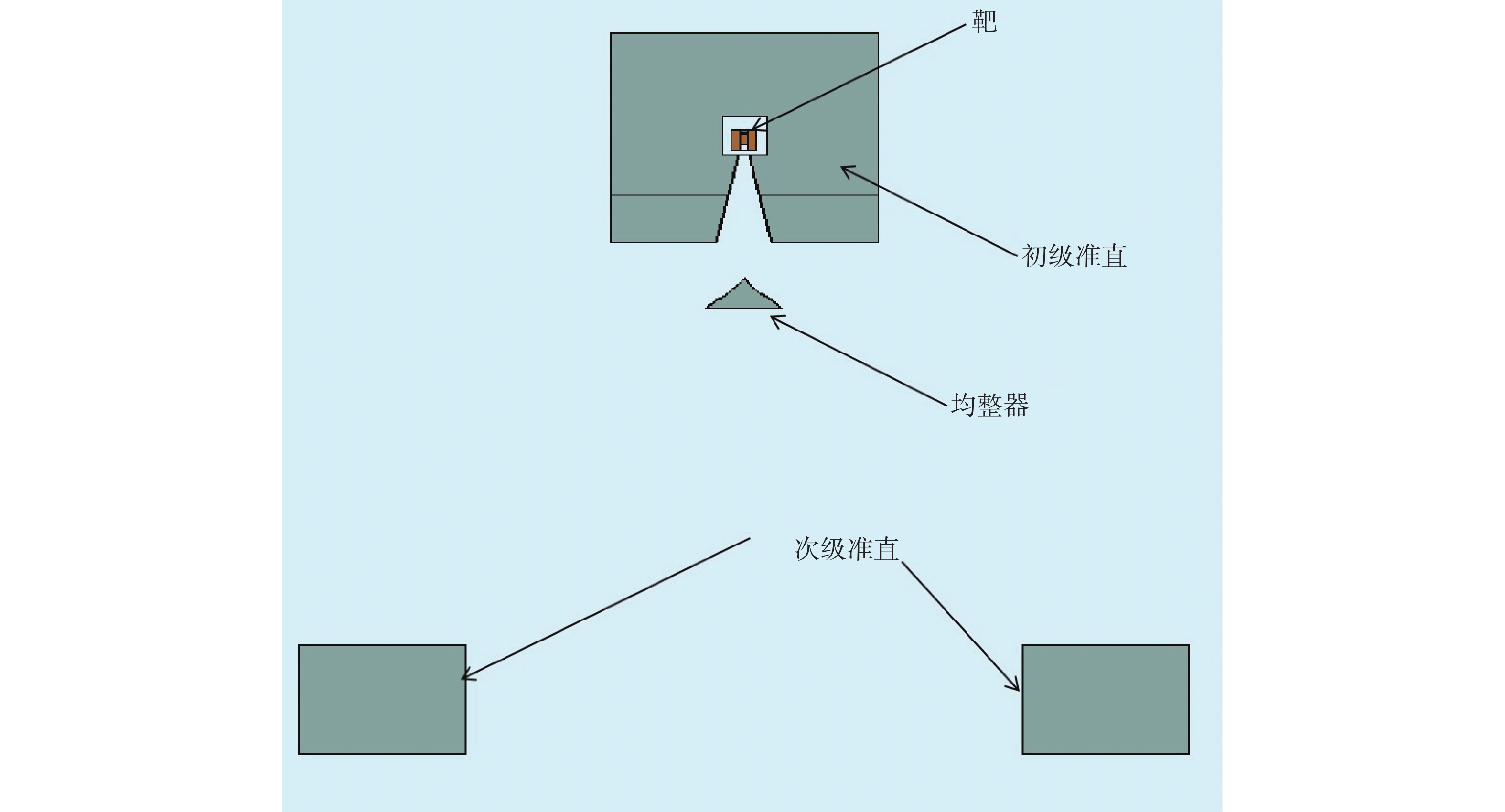恶性肿瘤成为威胁中国人群健康的重要疾病,根据国家癌症中心最新发布的全国癌症统计数据,2015年中国新发恶性肿瘤392.9万例,恶性肿瘤死亡病例233.8万例,恶性肿瘤导致的死亡占中国居民全死因的23.9%[1]。作为肿瘤治疗的三大利器之一,医用电子直线加速器(简称医用加速器)被广泛应用于临床实践具有举足轻重的作用,能有效挽救患者生命,给患者带来巨大利益,同时其对工作人员和公众带来潜在的辐射风险也备受关注[2-4]。分析加速器机房入口剂量分布及影响因素,对放射治疗机房的设计、建造和日常的监测、检测都有着非常重要的意义。
本研究结合广东省内某加速器治疗机房屏蔽设计方案,利用蒙特卡罗FLUKA程序[5-7]构建加速器机头和治疗机房几何模型,引入不同的条件和因素,模拟计算机房入口处周围剂量当量率的变化情况,分析加速器治疗机房入口的剂量分布及影响因素。
1 材料与方法 1.1 模型构建 1.1.1 加速器机头模型构建如图1,本文利用FLUKA程序编写加速器机头程序代码,构建了包括靶、初级准直、均整器和次级准直在内的加速器治疗头模型。其中电子束打靶的过程是在密闭的真空腔内完成,靶由金属材料钨和铜构成,初级准直器、均整器和次级准直器均由金属材料钨构成[8-9]。

|
图 1 加速器机头模型 Figure 1 Accelerator head model |
本次加速器机房模型按照广东省内某机房的实际尺寸,构建了几何模型,见图2。加速器机房屏蔽情况见表1。散射模体采用30 cm × 30 cm × 30 cm水模代替,密度为1.0 g/cm3。机房屏蔽体采用标准混凝土,密度为2.35 g/cm3。

|
图 2 加速器机房几何结构 Figure 2 Geometric structure of the accelerator treatment room |
|
|
表 1 加速器机房屏蔽情况一览表 Table 1 List of shielding conditions in the accelerator treatment room |
本研究采用的模拟计算软件为意大利核物理研究所(INFN)和欧洲核子研究中心(CERN)联合开发的基于蒙特卡罗方法的FLUKA 4.2.1程序。模拟过程以电子束打靶开始,电子初始动能为10 MeV。对于物理过程在FLUKA中调用了PRECISIO和PHOTONUC卡,利用USRBIN将空间分成若干相等的小格并记录小格中的光子通量,利用AUXSCORE卡引入ICRP74报告中的周围剂量转换系数AMB74计算剂量当量。考虑计算的时间等因素,模拟计算的历史数设置为1.00 × 109。并引入EMF-CUT卡将电子输运截止能量设置为0.7 MeV,光子输运截止能量设置为0.01 MeV[5]。源皮距SSD = 100 cm,光子束的射野范围设置为 40 cm × 40 cm方形野,机架角度分别取 0°(向下)、90°(向右)、180°(向上)和270°(向左)4个角度方向。通过模拟单个电子输运在加速器等中心点的周围剂量当量率归一化获取等中心点光子剂量率为600 cGy/min时加速器的电子束流强度为为3.37 × 1012 粒子/s。
1.4 模拟输出本次研究主要记录机房入口在等中心高度的周围剂量当量率,将机房入口宽度入口1 500 mm按100 mm一个记录小格等分为14个记录小格(记录小格的相对位置关系见图2),记录等中心高度上每个小格的周围剂量当量率。
2 结 果 2.1 迷路内墙厚度为1 800 mm时,机房入口周围剂量当量率在加速器机房迷路内墙厚度为1 800 mm时,有散射模体和无散射模体情况下,机架角分别取 0°、90°、180°和270° 4个角度方向,机房入口处周围剂量当量率模拟结果见表2。
|
|
表 2 迷路内墙厚度为1 800 mm时,机房入口周围剂量当量率 Table 2 Dose equivalent rate around the entrance of the treatment room at the inner labyrinth wall thickness of 1800 mm |
迷路内墙厚度为1 800 mm,机架角为90°,放置散射模体,改变加速器机房迷路内口的宽度,分别为1 400~2 200 mm,机房入口处周围剂量当量率模拟结果见表3。
|
|
表 3 不同迷路内口宽度时,机房入口周围剂量当量率 (μSv/h) Table 3 Dose equivalent rate around the entrance of the treatment room at different widths of inner labyrinth entrance (μSv/h) |
在加速器机房迷路内墙厚度为1 000 mm时,有散射模体和无散射模体情况下,机架角分别取 0°、90°、180°和270° 4个角度方向机房入口处周围剂量当量率模拟结果见表4。
|
|
表 4 迷路内墙厚度为1 000 mm时,机房入口周围剂量当量率 Table 4 Dose equivalent rate around the entrance of the treatment room at the inner labyrinth wall thickness of 1000 mm |
对于能量为10 MV的加速器机房,有用线束不照向迷路时,机房入口的处的辐射剂量中来自人体受有用线束照射时,散射至迷路在迷路内的二次散射、泄漏辐射在迷路内的散射辐射、穿过人体的有用线束辐射在主屏蔽墙上的散射在迷路内的二次散射和迷路内墙的泄漏辐射[10-12]。迷路内墙厚度为1 800 mm,有散射模体情况下不同机架角度时机房入口处的剂量率为(59.26 ± 37.71)~(243.14 ± 37.92)(机架角为90°) μSv/h,无散射模体情况下不同机架角度时机房入口处的剂量率为(21.22 ± 17.17)~(112.30 ± 48.59) (机架角为90°) μSv/h。对比迷路内墙厚度为1 800 mm机房入口的剂量率,机架角为90°时,机房入口处的周围剂量当量率最大,且有散射模体比无散射模体情况下大。迷路内墙厚度为1 000 mm,机架角度在0°和180°时有/无散射模体情况下,机房入口处的剂量率分别为(348.01 ± 71.20)、(142.89 ± 39.95) μSv/h和(327.06 ± 136.66)、(169.03 ± 45.68) μSv/h,机架角为90°和270°时有/无散射模体情况下,机房入口处的剂量率分别为(276.53 ± 91.40)、(170.93 ± 68.26) μSv/h和(139.36 ± 82.54)、(59.66 ± 39.50) μSv/h。对比迷路内墙厚度为1 000 mm机房入口处的剂量率,机架角为0°和180°情况下明显大于90°和270°的情况,且放置散射模体比无模体情况大。由此也证实对于有用线束不照向迷路内墙的加速器机房,机房入口处的辐射主要来源于迷路内墙泄漏辐射和人体的散射辐射[10-12]。
在迷路内墙厚度不变情况下,改变迷路内口的宽度为1 400 mm~2 200 mm时,对应机房入口处剂量率为(82.26 ± 48.95)~(314.09 ± 96.34) μSv/h。机房迷路内口的宽度越大,机房入口处的剂量率越大。迷路内口的宽度变化,导致患者散射辐射的二次散射的面积增加,同时散射路径长度变短,而机房入口处散射剂量与二次散射面积成正比[10],与散射路径长度的平方成反比。因此,机房内入口的剂量率随机房内入口宽度的增加而增加。
迷路内墙厚度为1 800 mm时,机房入口剂量率为(21.22 ± 17.17)~(243.14 ± 37.92) μSv/h,迷路内墙厚度为 1 000 mm时,机房入口剂量率为(59.66 ± 39.50)~(348.01 ± 71.20) μSv/h。对比迷路内墙厚度为1 800 mm和1 000 mm情况下机房入口的剂量率情况,在其他条件保持不变的情况下机房入口处的周围剂量当量率水平随迷路内墙厚度减少显著增加。可以看出机房迷路内墙主要用途是减少泄漏辐射对机房入口处辐射剂量的影响[10-12]。比较迷路内墙厚度为1 000 mm和1 800 mm机房入口处的剂量率。迷路内墙厚度为1 000 mm时,机房入口处周围剂量当量率在机架角为0°和180°时明显大于机架角为270°和90°的情况,可以看出机房入口处的辐射剂量率除跟迷路内口的情况相关外,还跟迷路内墙厚度相关,迷路内墙厚度直接影响机房入口处散射辐射和泄漏辐射的比重,而且可能导致泄漏辐射在机房入口处剂量占主导。因此,在日常监测、检测中应根据迷路内墙的实际厚度来确定机房入口处防护检测条件中的机架角度[13]。考虑到实际检测工作的时效性及检测人员的专业性等诸多因素,为了保障实际检测数据的全面性,建议机房入口处的辐射检测应该选择机架角度为0°、90°、180°和270°进行测量。
| [1] |
周泽宸, 余红平, 陈大方. 健康中国行动与肿瘤精准健康管理[J]. 中国癌症防治杂志, 2020, 12(5): 495-500. Zhou ZC, Yu HP, Chen DF. Healthy China action and accurate health management of cancer[J]. Chin J Oncol Prev Treat, 2020, 12(5): 495-500. DOI:10.3969/j.issn.1674-5671.2020.05.02 |
| [2] |
原雅艺, 左雅慧. 放射治疗诱导的二次原发肿瘤的研究进展[J]. 中国辐射卫生, 2019, 28(2): 209-213. Yuan YY, Zuo YH. Advances in secondary primary tumors induced by radiation therapy[J]. Chin J Radiol Health, 2019, 28(2): 209-213. DOI:10.13491/j.issn.1004-714X.2019.02.026 |
| [3] |
郎锦义. 中国放疗三十年回顾、思考与展望[J]. 肿瘤预防与治疗, 2017, 30(1): 1-4. Lang JY. Review, reflection and prospect of radiotherapy in China in the past 30 years[J]. J Cancer Control Treat, 2017, 30(1): 1-4. DOI:10.3969/j.issn.1674-0904.2017.01.001 |
| [4] |
李东, 刘平, 季芳, 等. 基于蒙卡GEANT4研究某放疗场所的辐射水平分布规律[J]. 中国辐射卫生, 2018, 27(4): 413-416. Li D, Liu P, Ji F, et al. Research on radiation distribution rule of a radiation therapy place based on GEANT4 Monte Carlo progress[J]. Chin J Radiol Health, 2018, 27(4): 413-416. DOI:10.13491/j.issn.1004-714X.2018.04.034 |
| [5] |
Ferrari A, Sala P R, Fassò A, et al. FLUKA: a multi-particle transport code[R]. Menlo Park: SLAC National Accelerator Lab, 2021: 43-295.
|
| [6] |
邹剑明, 许志强, 耿继武, 等. 基于蒙特卡罗方法的质子治疗室屏蔽防护探讨[J]. 中国辐射卫生, 2019, 28(4): 443-446. Zou JM, Xu ZQ, Geng JW, et al. Radiation shielding design of proton therapy treatment room based on the Monte Carlo method[J]. Chin J Radiol Health, 2019, 28(4): 443-446. DOI:10.13491/j.issn.1004-714X.2019.04.026 |
| [7] |
金潇, 严源, 韩春彩. 高能质子治疗系统辐射环境影响评价关键问题探讨[J]. 中国辐射卫生, 2020, 29(1): 65-68. Jin X, Yan Y, Han CC. Discussion on some key issues in radiation environmental impact assessment of high energy proton therapy system[J]. Chin J Radiol Health, 2020, 29(1): 65-68. DOI:10.13491/j.issn.1004-714X.2020.01.015 |
| [8] |
赵洪斌, 张新, 包尚联, 等. 电子直线加速器辐射场优化的蒙特卡洛模拟(英文)[J]. 南京航空航天大学学报, 2010, 27(1): 7-12. Zhao HB, Zhang X, Bao SL, et al. Monte Carlo simulation of radiation field optimization for medical linac[J]. Trans Nanjing Univ Aeronaut Astronaut, 2010, 27(1): 7-12. DOI:10.3969/j.issn.1005-1120.2010.01.002 |
| [9] |
时颖华, 周凌宏, 刘迎军, 等. 6 MV医用电子直线加速器的蒙特卡罗模拟[J]. 中华放射医学与防护杂志, 2011, 31(2): 220-224. Shi YH, Zhou LH, Liu YJ, et al. Monte Carlo simulation of 6 MV medical electron linear accelerator[J]. Chin J Radiol Med Prot, 2011, 31(2): 220-224. DOI:10.3760/cma.j.issn.0254-5098.2011.02.028 |
| [10] |
中华人民共和国卫生部. GBZ/T 201.2—2011 放射治疗机房的辐射屏蔽规范 第2部分: 电子直线加速器放射治疗机房[S]. 北京: 中国标准出版社, 2011. Ministry of Health of the People's Republic of China. GBZ/T 201.2—2011 Radiation shielding requirements for radiotherapy room. Part 2: radiotherapy room of electron linear accelerators[S]. Beijing: Standards Press of China, 2011. |
| [11] |
傅强, 王璐, 刘芳, 等. 某医用电子加速器机房的屏蔽核算探讨[J]. 中国辐射卫生, 2017, 26(4): 404-407. Fu Q, Wang L, Liu F, et al. Discussion on radiological protection calculation on the main shieldings of a medical electron accelerator room[J]. Chin J Radiol Health, 2017, 26(4): 404-407. DOI:10.13491/j.cnki.issn.1004-714X.2017.04.007 |
| [12] |
National Council on Radiation Protection and Measurements. Structural shielding design and evaluation for megavoltage X-and gamma-ray radiotherapy facilities[R]. NCRP Report No. 151, Bethesda: NCRP, 2005.
|
| [13] |
周媛媛, 杨春勇, 王福如, 等. 不同照射条件下医用加速器机房辐射水平验证检测[J]. 中国辐射卫生, 2014, 23(1): 11-13. Zhou YY, Yang CY, Wang FR, et al. Verification testing of radiation levels of medical accelerator rooms under different irradiation conditions[J]. Chin J Radiol Health, 2014, 23(1): 11-13. DOI:10.13491/j.cnki.issn.1004-714X.2014.01.004 |



